|
|
Ten Days With the Deaf and Dumb, continued

Dr. Harvey L. Peet
A very large majority of the pupils are beneficiaries of the State, which provides for the education of all her deaf-mutes between the ages of twelve and twenty-five, if they need her aid. Deaf-mute children between the ages of six and twelve, also, if already a charge for maintenance upon any county or town, may be sent to the institution at the expense of such county or town. The fifty-third annual report shows that of the five hundred and thirty-four pupils in school September 30, 1871, three hundred and forty-seven were supported by the State of New York, one hundred and thirty-eight by the counties to which they belonged, thirty-two by the State of New Jersey, and less than twenty by their friends. We must not infer, however, that almost all of these pupils come from homes of poverty. Many of them belong to respectable familes who could provide comfortably for the needs of ordinary children at home, though they are not able to pay out the sums required to keep them at school for a long course of years. It costs here about three hundred dollars a year for each pupil, besides Page 4
These pages are © Laurel O’Donnell, 2006, all rights reserved Copying these pages without written permission for the purpose of republishing in print or electronic format is strictly forbidden. Books & articles appearing here are modified adaptations. This page was last updated on 01 Jul 2006 |
